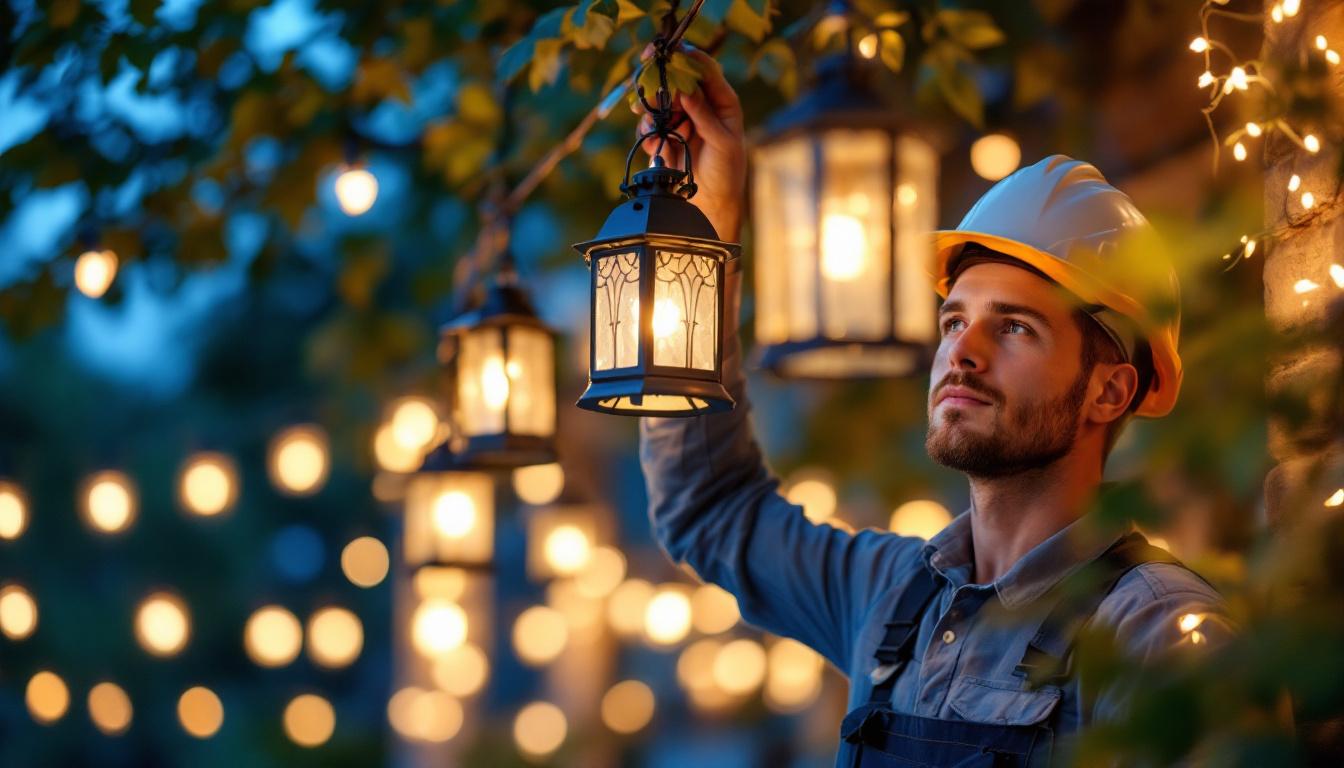
Lighting contractors play a pivotal role in creating inviting and functional spaces through the careful installation of lighting fixtures. Among the various lighting options available, lanterns have gained popularity for their aesthetic appeal and versatility. However, even the most experienced contractors can fall prey to common mistakes when it comes to hanging lanterns. Understanding these pitfalls can help ensure that projects are executed flawlessly, enhancing both the beauty and functionality of the spaces they illuminate.
Before delving into the common mistakes, it is essential to grasp the fundamental aspects of lantern installation. Lanterns are not just decorative elements; they serve practical purposes as well. Proper installation requires an understanding of the space, the type of lantern being used, and the electrical requirements involved.
The selection of the appropriate lantern is the first step in a successful installation. Contractors often overlook the importance of matching the lantern style to the overall aesthetic of the space. A modern lantern in a rustic setting can create a jarring visual effect, detracting from the intended ambiance.
Additionally, it is crucial to consider the size and scale of the lantern. A small lantern may get lost in a large room, while an oversized fixture can overwhelm a cozy space. Taking the time to assess the environment and select a lantern that complements it will lead to a more cohesive design. Moreover, the material of the lantern can also play a significant role in the overall feel of the space. For instance, metal lanterns can impart a sleek, industrial vibe, while glass or ceramic options might evoke a more traditional or artisanal atmosphere. Exploring various materials can enhance the character of your installation, making it not just a source of light but a statement piece that ties together the room’s decor.
Lanterns come in various styles, including pendant, wall-mounted, and post-mounted options, each with distinct electrical requirements. Contractors must ensure that the existing electrical infrastructure can support the chosen lantern. This includes checking the wattage, voltage, and compatibility with dimmer switches if applicable.
Failing to address these electrical considerations can lead to flickering lights, blown fuses, or even hazardous situations. It is advisable to consult with an electrician when in doubt, ensuring that the installation meets safety standards and functions as intended. Furthermore, considering the placement of the lantern in relation to existing light sources is essential. For instance, a lantern positioned near a window may require a different wattage or type of bulb than one located in a darker corner of a room. Additionally, understanding the color temperature of the bulbs used can significantly affect the atmosphere; warm white bulbs can create a cozy ambiance, while cooler tones might be better suited for task-oriented areas. Taking these factors into account will not only enhance the functionality of the lantern but also elevate the overall aesthetic of the space.
Placement is a critical factor in the effectiveness of lanterns. Many contractors make errors in positioning that can compromise both aesthetics and functionality. Understanding the common pitfalls can help avoid these mistakes.
One of the most frequent mistakes is neglecting the proper height at which to hang lanterns. For pendant lanterns, a general rule of thumb is to hang them 30 to 36 inches above a dining table or kitchen island. However, this can vary based on ceiling height and the specific design of the space.
Hanging lanterns too high can diminish their visual impact, while hanging them too low can obstruct views and create a cramped atmosphere. It is essential to consider the scale of the room and the intended use of the space when determining the appropriate height. Additionally, it is wise to take into account the type of activities that will take place under the lanterns. For example, in a dining area, a lower hanging lantern can create an intimate atmosphere, while in a workspace, a higher placement might be more suitable to ensure adequate lighting without hindering movement.
Lanterns should contribute to the overall balance of a room. Contractors often make the mistake of placing lanterns without considering the symmetry of the space. For instance, if a lantern is hung on one side of a room, it may be beneficial to add another on the opposite side to create visual harmony.
In larger spaces, grouping lanterns in clusters can also enhance the aesthetic appeal. This approach not only provides adequate lighting but also creates a focal point that draws the eye and adds depth to the design. Furthermore, varying the sizes and styles of lanterns within a cluster can introduce an element of interest, allowing for a playful yet cohesive look. When designing with symmetry in mind, it’s also important to consider the surrounding decor—ensuring that the lanterns complement other elements, such as artwork or furniture, can elevate the overall ambiance of the room.
The quality of light emitted by lanterns can significantly impact the ambiance of a space. Many contractors focus solely on the fixture’s appearance, overlooking the type of bulbs used and the overall lighting quality.
Different types of bulbs produce varying qualities of light. For example, incandescent bulbs provide a warm glow, while LED bulbs can offer a cooler, more modern light. Contractors must consider the desired atmosphere when selecting bulbs for lanterns.
Additionally, the color temperature of the bulbs plays a crucial role. A warm white light (around 2700K) is often preferred for residential spaces, as it creates a cozy and inviting environment. On the other hand, cooler white lights (above 4000K) may be more suitable for task-oriented areas such as kitchens or workspaces.
Another common oversight is the failure to incorporate dimming options into the lighting design. Dimmers allow for flexibility in adjusting the light levels according to the time of day or the activity taking place. This feature can enhance the functionality of lanterns, making them suitable for various occasions.
Contractors should ensure that the installed fixtures are compatible with dimmer switches and that the electrical system can support this feature. This consideration not only improves user experience but also adds value to the overall lighting installation.
The techniques employed during installation can significantly affect the performance and longevity of lanterns. Many contractors make mistakes that can lead to issues down the line.
One of the most critical aspects of lantern installation is ensuring that the fixture is securely mounted. Contractors sometimes rush through this process, leading to loose fixtures that can sway or even fall. This not only poses a safety hazard but can also damage the fixture itself.
Using the appropriate mounting hardware and ensuring that the fixture is level are essential steps in the installation process. Taking the time to double-check these details can prevent future complications and ensure a professional finish.
For outdoor lanterns, weather resistance is a crucial factor that should not be overlooked. Many contractors mistakenly use indoor-rated fixtures in outdoor settings, leading to premature wear and potential safety hazards.
When selecting lanterns for outdoor use, it is vital to choose fixtures that are specifically designed to withstand the elements. This includes considerations for moisture, UV exposure, and temperature fluctuations. Investing in weather-resistant fixtures can save time and money in the long run by reducing the need for replacements.
Effective communication with clients is paramount for the success of any lighting project. However, many contractors fail to engage their clients adequately throughout the installation process, leading to misunderstandings and dissatisfaction.
From the outset, it is essential to set clear expectations regarding the project timeline, costs, and design choices. Contractors should take the time to discuss the client’s vision and ensure that both parties are aligned on the desired outcome.
Regular updates during the installation process can also help keep clients informed and engaged. This transparency fosters trust and allows for any adjustments to be made promptly, ensuring that the final result meets or exceeds expectations.
After the installation is complete, many contractors neglect to provide clients with guidance on maintaining their new lanterns. This oversight can lead to issues down the line, as clients may not know how to care for their fixtures properly.
Providing clear instructions on bulb replacement, cleaning, and general upkeep can enhance the longevity of the lanterns and ensure that they continue to perform well. This attention to detail can also improve client satisfaction and encourage referrals for future projects.
Hanging lanterns can transform a space, adding both beauty and functionality. However, lighting contractors must be aware of the common mistakes that can undermine their efforts. From selecting the right lantern to ensuring proper installation techniques, attention to detail is crucial.
By understanding the importance of placement, lighting quality, installation methods, and effective communication with clients, contractors can elevate their work and deliver exceptional results. Avoiding these common pitfalls not only enhances the contractor’s reputation but also leads to satisfied clients and successful projects.
Ultimately, the goal is to create spaces that not only look good but also feel good. With careful planning and execution, lantern installations can achieve this goal, illuminating homes and businesses with style and grace.
Ready to elevate your lighting installations with the finest lanterns and avoid common pitfalls? Choose LumenWholesale for an unparalleled selection of top-quality, spec-grade lighting products at wholesale prices. Our commitment to excellence ensures that you receive reliable and high-performance lighting that meets the highest industry standards. With free shipping on bulk orders, you can stock up on premium lighting solutions without worrying about hidden fees or inflated markups. Make your next project shine with the perfect blend of quality, affordability, and convenience. Discover Wholesale Lighting at the Best Value today and light up your spaces with confidence and style.

Discover how LED linear lighting is revolutionizing the work of lighting contractors by enhancing efficiency, reducing costs, and offering versatile design options.

Discover essential tips for lighting contractors by exploring common pitfalls to avoid on Seagulllighting.com.

Discover the essential guide for lighting contractors on sconces lighting fixtures.

Discover the essential facts about 6-inch LED recessed lights that every lighting contractor should know.